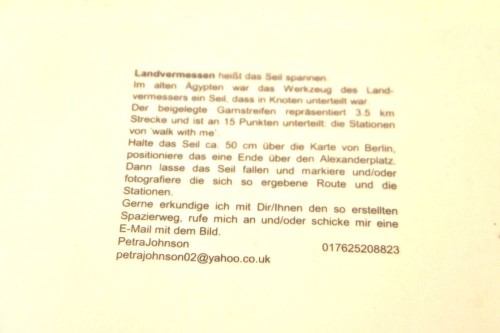‚walk with me‘ is an interactive work which consists of three components:
1. Rehearsal – 3 days in a park or public venue
2. Activity – walking a pre-determined route (daily for 11 days)
3. Material outcomes – a book, an archive, a graphic work, a multiple screen video

1. Rehearsal
The public rehearsal consists of three sessions during which an object is fabricated. Each session lasts three hours and takes place in a public venue. The object is a map of the route that will be walked during the second stage: the activity. Before I and my walking companion (a local) weave our way through the streets of the city, the route is isolated from its daily environment. Before the foot will touch the ground, fingers and hands will make visible the twists and turns of the route to the eye. Bereft of context, the route which is represented by a line of twine and held in place by transparent threads, ploughs a furrow in the imagination of those who are not familiar with the city and triggers memories in those who inhabit the city.
The site: A public park or similar
The audience: incidental
The duration: 3 hours each over three days
The schedule: 1 morning session, 1 afternoon session, 1 evening session






 Picture 1 – 8 Galerie Nord
Picture 1 – 8 Galerie Nord
2. Activity
A one to one walk from a small convenience store or kiosk to an iconic building (exact locations will be finalised during part 1: Rehearsal) ‚walk with me‘ seeks to make visible the composition of the ordinary. By applying a tight structure with set rules (as in a game), ‚walk with me‘ provides a territory that is potentially free from ideology. The participants are the artist and one companion. The route is pre-determined yet each participant defines them afresh in their response to instigating prompts handed out at intervals. These prompts create an aesthetic milieu in which artist and companion co-create together. Suspended from everyday activities they share memories, they observe small acts of everyday life, they note the mood of a moment, they sense the constancy of moving bodies walking in unison, they hear the rhythmic sound of soles tapping the ground.
3. Epilogue – material outcome
A series of 15 booklets containing collections of observations, memories, photos and drawings. A multi screen video juxtaposing walks in different cities and graphics and maps of the route walked.
Project Summary
‚walk with me‘ proceeds from Johnson’s love and curiosity about strangers whom she invites to walk with her. The walks along pre-determined routes take her (who is a stranger in town) and her companion (who is local) from a small convenience store in a neighbourhood to a monument or landscape that shapes the identity of the city, she and her companion traverse. The 2 – 3 hour long walks are interspersed with prompts which focus the walkers‘ attention across a field of sensations.
A time of transition is an opportunity to re-negotiate our relationship to traditions and values. This cannot be done in isolation and yet it should be done in a manner that is not dominated by one culture. ‚walk with me‘ does not set out to say anything in particular. Instead it sets aside time. Time during which two protagonists walk between two anchor points. By the time they have reached the opposite point (the walk can go in either direction) they have created a community of two through conversing. Walking is also a sharing of rhythm. It is a juxtapositioning of visual events with corporeal rhythms. It is two bodies sharing sensual reactions. ‚walk with me‘ asks: What possible forms can arise out of our experiencing together? What energy has the ‚we‘ that the walk creates? How can it be harnessed for an emerging future? ‚walk with me‘ works with the recognition that the earth is a ’synthesis of my perception and the other‘, that it is ‚an experiential basis for all bodies‘ (Husserl). Any walk with a stranger is outside the established order and contains a state of possibility. There are fifteen points on route where my companion and I write down our impressions. These intervals of thinking, of standing still, of putting meaning into words is also a ‚human writing‘. As Solnit writes, ‚walking for pleasure between two points returns the space between into a garden, a ‚public garden without walls‘. (2002: 167).
The French philosopher and sinologist Francois Jullien argues that ‚Transition literally forms a gap in European thought and reduces it to silence.‘ To the European imagination’, he continues, ‚between before and after is the strange‘. (2010: 24-25) During the walk, we, the walkers, change our identity of being strangers to each other to one of becoming familiar with each other and in doing so we incarnate commensality.




 Picture 9 – 13 Galerie M
Picture 9 – 13 Galerie M